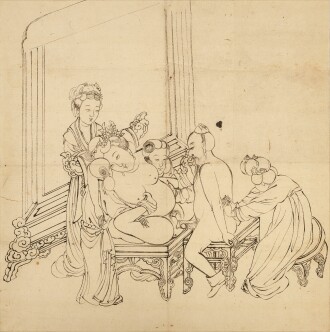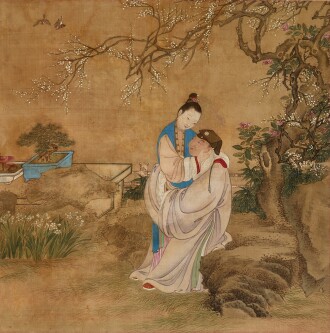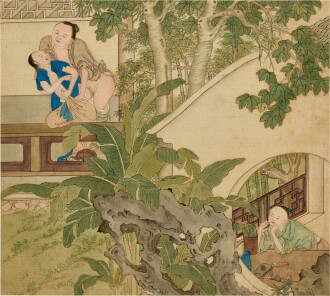B orn in Calcutta into a wealthy Brahmo family, Rabindranath Tagore went on to become one of the most revered poet-philosophers of his time. In 1913, he was awarded the Nobel Prize for Literature, the first non-Westerner to be honoured with the award. A poet, author, playwright and artist, Tagore's creative output was immense. What began as doodling on his working manuscripts became an obsession after 1930 and continued throughout the last ten years of his life. Two of his works will go on sale as part of Sotheby's Modern and Contemporary South Asian Art sale in London on 23 October.
Image courtesy The Dartington Hall Trust archive
The human face is a noticeable constant in Tagore’s output. As a writer par excellence, he connected human appearance with emotions and essence, something which transcended to his art as well. Tagore’s faces reveal a myriad of moods: melancholic, mysterious, menacing, melodramatic, and romantic.
Tagore’s work in general is imbued with sadness. His mother passed away when he was a boy, and his life was marked by continued personal tragedy. He was plagued with grief after the suicide of his childhood playmate, sister-in-law and literary companion, Kadambari Devi, and the years between 1902 and 1907, saw the deaths of his wife, daughter and youngest son.
Reproduced in R. Parimoo, Art of Three Tagores: From Revival to Modernity, Kumar Gallery, New Delhi, 2011, p. 498
Tagore’s emotional state, solitude and longing for companionship are articulated in his literary works such as Mahua and Purabi. The latter includes poems dedicated to another companion, the Argentinian writer and intellectual, Victoria Ocampo, the woman instrumental in organising his 1930 exhibition in Paris. Their idyllic encounter was short lived and it is said that this separation too was hard on him.
Of his ‘heads’, Tagore’s female figures are especially well-known. Mulk Raj Anand, in a 1961 Marg essay, elaborated ‘Their gentle eyes and melancholy faces are half opaque… The pain has ceased but the pathos lingers. The pain lingered so much that this oval faced woman came back again and again with her head cloth flowing in mellow colours transmitting dream into reality on an absolute pain.’ (M. Anand, ‘Paintings of Rabindranath Tagore,’ Something Old Something New: Rabindranath Tagore 150th Birth Anniversary Volume, Marg Publications, 2011, p. 41)
Lot 3 is an exceptional case in point. It perfectly demonstrates Tagore’s talent of metaphorical painting. The woman, rendered in a multi-chromatic scheme, has been offset on the left of the picture plane. The negative space consists assorted tempered hues of green, ochre and a dull pink. There is a flicker of light on her face - as if emerging from darkness at the crack of dawn, a dawn which breaks over the horizon in shell pink and faint gold: the hour of silence when nothing moves except light.
Tagore uses intense colours to captivate his audience with portraits that exude a sense of enigma. Unlike most of his individual faces which engage directly with the viewer, this one seems to be looking at something beyond. There is a wordless theatre at play here which teases us into an empathetic immersion.
The appreciation for his paintings and drawings grew in leaps and bounds with time and there has been a tremendous shift in the market for Tagore’s works. In 1976, the Government of India declared his work a national treasure with regard to his ‘artistic and aesthetic value’ and prohibited the exportation of his works outside the country. The provenance of Tagore’s work has also played a significant role in their ‘value’. Given his stature as a noble laureate and national hero, Tagore was associated with many world luminaries who bought or were gifted his work. One such family were the Elmhirsts of Dartington Hall, England.
Image courtesy The Dartington Hall Trust
Leonard Elmhirst was a close friend of Rabindranath, having first met the poet whilst studying agricultural economics at Cornell University, New York, from 1919-1921. Post-graduation, on the invitation of Tagore, Elmhirst visited India to help run a farm project in Surul near Santiniketan. In 1924, Tagore asked Elmhirst to accompany him as his personal secretary on a tour of China, Japan and Argentina to exchange cultural ideas and methods of farming. On his return, Tagore instructed Elmhirst - “You must marry and create an institution of your own – in England. Choose some place, preferably in Devon, it is so beautiful there.” (Rabindranath Tagore, 1925, The Dartington Hall Trust Archives).
Sotheby’s London, 15 June 2010, lot 26
Property from The Dartington Hall Trust
Sold for £313,250
The Dartington Hall Trust was created in the 1930s by Leonard and his American wife, Dorothy. The daughter of the millionaire William C. Whitney, Dorothy funded the renovation and development of Dartington, a medieval hall set within a 1,200 acre estate in South Devon, purchased by the Elmhirsts in 1925. Elmhirst recalls ‘Here my wife and I were trying to establish a variety of enterprises, educational, research and commercial, not unlike a mingling of Santiniketan and Sriniketan. Tagore has visited us there in 1926 and after his first exploration of the garden and river below, to my question ‘whether it would do?’ had replied “Elmhirst, it will do”’. (The Dartington Hall Trust archives)
On Tagore’s second visit to Dartington in 1930, aged 69, ‘[he] asked for bottles of coloured ink, and, when these arrived, there began to emerge a series of paintings and sketches.’ (The Dartington Hall Trust Archives). Leonard and Dorothy had two children, Ruth and William. This particular work hailed from the personal collection of William Elmhirst. Tagore is also known to have gifted seventeen works to the Dartington Trust, some of which were sold in a de-accession at Sotheby’s London, 15 June 2010. The works achieved unprecedented record prices for the time, highlighting the tremendous interest in Tagore's paintings in India and across the world.
















![View 1 of Lot 3659: Scenes from Xixiangji [Romance of the western chamber] Qing dynasty, early 19th century | 清十九世紀初 〈西廂記〉插畫 一冊十四幀 附詩文 設色紙本](https://sothebys-com.brightspotcdn.com/dims4/default/d62e8c4/2147483647/strip/true/crop/4285x5379+0+0/resize/300x376!/quality/90/?url=https%3A%2F%2Fsothebys-md.brightspotcdn.com%2Fe8%2Faa%2Fd1f5cbb54a81865c754bc120e051%2Fhk1209-c5nth-13-t2-v1.jpg)
![View 1 of Lot 3660: Scenes from Rou putuan [The carnal prayer mat] Qing dynasty, 18th century | 清十八世紀 〈肉蒲團〉插畫 一冊十一幀 設色紙本](https://sothebys-com.brightspotcdn.com/dims4/default/89142d3/2147483647/strip/true/crop/2000x1999+0+0/resize/330x330!/quality/90/?url=https%3A%2F%2Fsothebys-md.brightspotcdn.com%2Fb0%2Feb%2F06ab94aa41d594c9e05ba45b2993%2Fhk1209-c5ntj-2-t2-v1.jpg)







